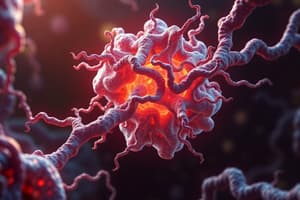Podcast
Questions and Answers
What is the role of the signal-recognition particle (SRP) in protein trafficking to the ER?
What is the role of the signal-recognition particle (SRP) in protein trafficking to the ER?
The SRP binds to both the ribosome and the ER signal sequence when it emerges from the ribosome, slowing down protein synthesis until it engages with an SRP receptor on the ER membrane.
How does the SRP receptor contribute to protein trafficking to the ER?
How does the SRP receptor contribute to protein trafficking to the ER?
The SRP receptor, embedded in the ER membrane, recognizes the SRP bound to the ribosome, passes the ribosome to a protein translocator in the ER membrane, and releases the SRP.
Explain the process by which the polypeptides are transferred across the ER membrane.
Explain the process by which the polypeptides are transferred across the ER membrane.
The polypeptides are threaded across the ER membrane through a channel in the translocator, facilitated by the SRP and SRP receptor.
What are the functions of the SRP and SRP receptor in protein translocation to the ER membrane?
What are the functions of the SRP and SRP receptor in protein translocation to the ER membrane?
Why does the binding of an SRP to a ribosome displaying an ER signal sequence slow down protein synthesis?
Why does the binding of an SRP to a ribosome displaying an ER signal sequence slow down protein synthesis?
Flashcards are hidden until you start studying




